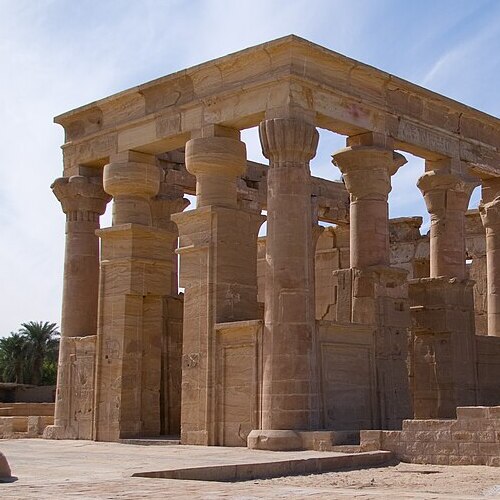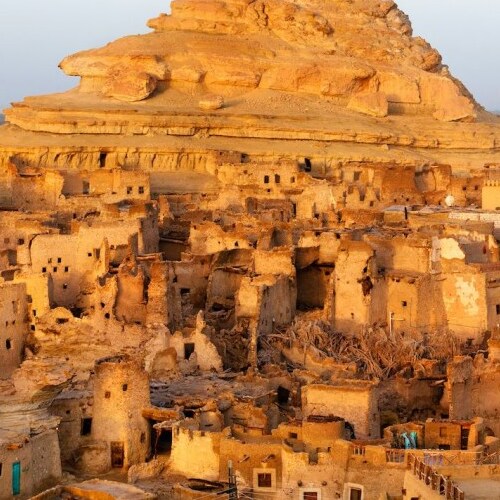No other nation in the world says ‘Welcome’ as often as the Egyptians, and every time, they mean it. While the ancient civilization of Egypt continues to amaze, contemporary Egyptians are equally remarkable.
The Roman Fortress at Dush
The Roman Fortress at Dush
Located at the southernmost edge of Kharga Oasis, the Roman Fortress at Dush, known simply as el-Qasr (‘the Fortress’), stands as a testament to the historical richness of this region. This mudbrick structure, measuring approximately 30m by 20m, once served as a vital military outpost during Roman times. It’s debated whether its primary function was as a military guard-post or as a checkpoint controlling the trade route along the southern end of the Darb El-Arba’in.
The Setting of Dush
Dush is strategically positioned about 15km northeast of El-Qasr, at a convergence of five ancient desert tracks. Notably, one of these tracks, the Darb el-Dush, linked this outpost directly to the Nile valley towns of Esna and Edfu, marking it as a critical route in Roman times. The surrounding hill of Dush is also the site of Kysis, one of the oldest Roman ruins in Kharga Oasis. Once a frontier town, it housed a large garrison of Roman troops and included a mudbrick fortress (Qasr Dush) and two temples. To the north and northeast of the fortress lay an extensive necropolis, where funeral workers thrived, evidenced by a rich archive of documents from AD 237 to AD 314.
Archaeological Discoveries and Excavations
French archaeologists from the IFAO have been investigating the area around Dush since 1976. Their findings suggest temporary occupation dating as far back as the Old Kingdom, possibly Dynasty IV. Persian and Ptolemaic Period settlements were identified on the hill slopes, and the earliest fortress, encompassing a rectangular area at the hill’s summit, was either Ptolemaic or Persian in origin.
The Roman fortress, expanded from the original Ptolemaic structure, still stands with massive mudbrick walls reaching 6m to 12m in some places. Inside, dense barrack structures and deep underground chambers span four or five levels.
Qasr Ad Dush and Its Treasures
Adjacent to the Roman fortress lies a sandstone temple, likely initiated by Domitian, enlarged by Trajan, and partly decorated by Emperor Hadrian between the 1st and 2nd centuries AD. Dedicated initially to Osiris, later to Serapis and Isis, the temple is fronted by a monumental stone gateway bearing a dedicatory inscription by Trajan dated AD 116.
In 1989, French archaeologists discovered the ‘Dush Treasure’ in the temple’s western side, including a gilded statuette of Isis, bronze figures, and a pottery jar concealing gold religious jewelry and ex-votos objects, now housed in the Cairo Egyptian Museum. These artifacts, dating from the 4th to 5th centuries AD, offer invaluable insights into Roman worship in Egypt.
Life and Religion in Dush
The temple area has yielded numerous artifacts, including pottery, coins, and ostraca. These findings reveal a blend of Egyptian, Greek, Roman, and biblical Hebrew names, indicating that Christianity was practiced in Dush. Private letters in the form of ostraca provide insights into the daily lives of those in this Roman outpost.
Another smaller mudbrick temple lies about 200 meters west of the main temple, its function and history still enigmatic.
The Decline of Kysis
The town of Kysis, once vibrant around the fortress, is now marked by ruins and cemeteries. The discovery of clay pipes and a Christian church suggests the town was abandoned after its wells dried up post-fourth century AD.
The Future of Dush's Archaeological Sites
Recent excavations at ‘Ayn Manawir, about 5km northwest of Qasr Dush, uncovered an entire village with houses, fields, orchards, and a novel irrigation system. This site, a Persian and Roman settlement, has provided a wealth of archaeological and textual evidence, enhancing our understanding of the region’s history.
However, the advancing sand dunes threaten to engulf ‘Ayn Manawir, potentially halting future excavations and burying this significant archaeological site once again beneath the desert sands.
Created On March 18, 2020
Updated On Aug , 2024



